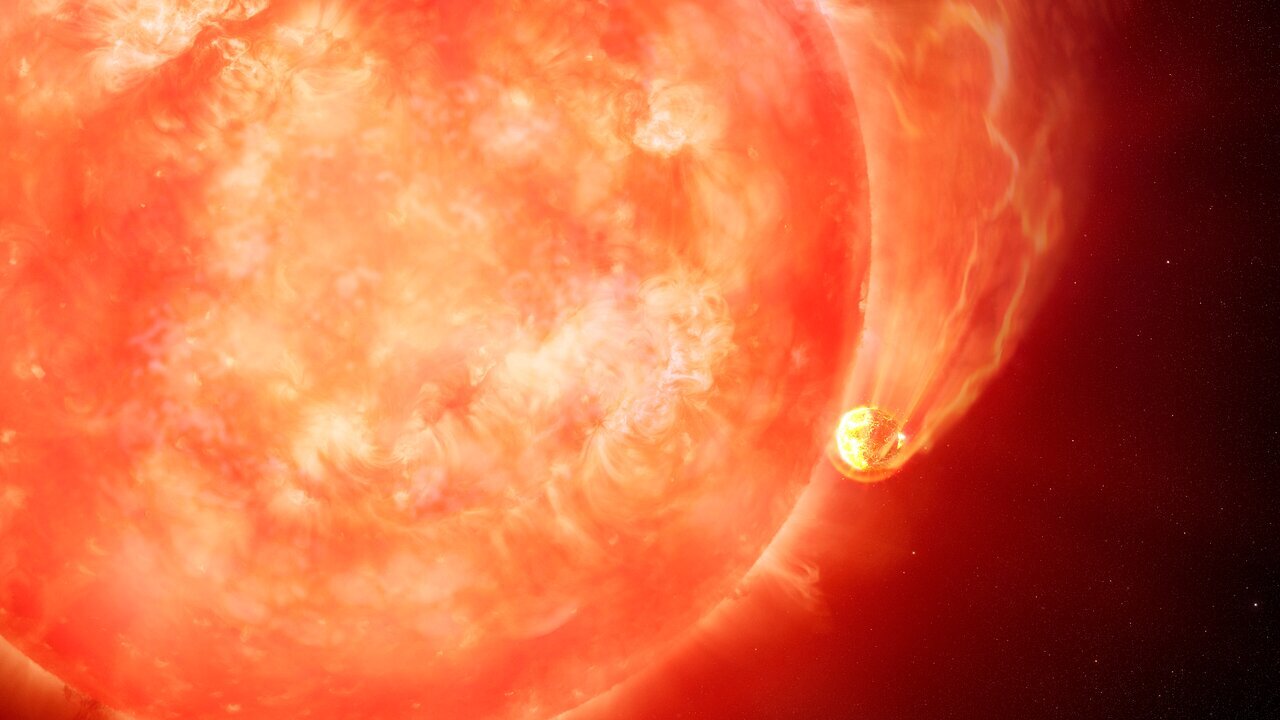Astronomers have gathered the first convincing evidence that a dying sun-like star is engulfing an exoplanet. This unprecedented process may represent Earth’s final fate as our sun approaches the end of its life in about five billion years.
By studying countless stars in various stages of development, astronomers have sought to understand the life cycle of stars and how they interact with planets as stars age. These studies confirm that as a sun-like star approaches the end of its life, it expands from 100 to 1,000 times its original size, eventually engulfing the system’s inner planets. It is estimated that such events only occur a few times a year throughout the Milky Way. While previous observations have confirmed the consequences of planetary engulfment, astronomers have never detected them until now.
Using the Gemini South Telescope at the Gemini Observatory, astronomers have obtained the first direct observation providing evidence of a dying star expanding to engulf one of its planets. This was seen in a distinct “long-lived, low-energy” starburst in the Milky Way about 13,000 light-years from Earth. This devouring of the planet by a bulging star will likely reveal the ultimate fates of Mercury, Venus and Earth when our sun begins to die in about five billion years.
Astronomers using the Gemini South Telescope in Chile, operated by NSF NOIRLab, have observed the first convincing evidence of a dying sun-like star engulfing an exoplanet. Credit: Gemini Observatory/NOIRLab/NSF/AURA/M International. Garlick / M. Zamani / N. Bartman
Sun-like stars spend most of their lives fusing hydrogen into helium in their hot, dense cores. When the hydrogen in the core runs out, the star begins to fuse helium into carbon, and hydrogen fusion travels to the star’s outer layers, causing them to expand and transform the sun-like star into a red giant.
However, such a shift is bad news for the planets. As the star’s surface expands, it begins to engulf its planets, causing spectacular explosions. In addition, this process reduces the planet’s orbital velocity, which speeds up its rush to the star.
The first hints of the reality of this scenario were spotted in observations of the Zwicky Transit Facility. Observations of the phenomenon, dubbed ZTF SLRN-2020, made in infrared by NASA’s Near Earth Object Wide-field Infrared Explorer (NEOWISE), provided further evidence.
Pictured: the successive stages of a planet engulfed by an expanding star. Source: Gemini Observatory/NOIRLab/NSF/AURA/P International. Marienfeld
It is difficult to distinguish a planetary engulfment flare from other types of flares, such as solar flares and coronal mass ejections, and requires high-resolution observations. The Gemini South Telescope allowed the collection of relevant data thanks to its adaptive optics capabilities.
“Gemini south expands our knowledge of the universe, and these observations confirm predictions about the future of our planet,” said Martin Steele, program manager for the NSF Gemini Observatory.
“Thanks to new optical and infrared surveys, we are now witnessing events like this happening in our Milky Way in real time — a testament to our almost certain future as a planet,” said Kechalay D, an MIT astronomer. and lead author of the paper.
The glow from the engulfing planet lasted about 100 days, and the curve properties of the light as well as the ejected matter gave astronomers insight into the mass of the engulfing star and planet. The ejected material consisted of hydrogen with a mass of about 33 Earth masses and dust with a mass of about 0.33 Earth masses. Based on this analysis, the team estimated that the star’s mass was about 0.8 to 1.5 times that of our Sun, and that the submerged planet had a mass 1 to 10 times that of Jupiter.
Astronomers can now look for similar events in other parts of the universe. This will be especially important when the Vera C. Rubin Observatory becomes operational in 2025.
“I think there is something unusual about these results that speaks to the transience of our existence,” says Ryan Lau, NOIRLab astronomer and co-author of the study, which was published in the journal Nature. “After billions of years in the life of our solar system, our final end will likely be a flash that only lasts a few months.”
More information: Posted by Kishalay De et al. “Transient infrared radiation from a star swallowing a planetNature (2023). DOI: 10.1038/s41586-023-05842-x
Prepared by Joanna Molinda-Akowicz
Pictured: an exoplanet engulfed by a star. Credit: Gemini Observatory/NOIRLab/NSF/AURA/M International. Garlick / M. Zamani

Echo Richards embodies a personality that is a delightful contradiction: a humble musicaholic who never brags about her expansive knowledge of both classic and contemporary tunes. Infuriatingly modest, one would never know from a mere conversation how deeply entrenched she is in the world of music. This passion seamlessly translates into her problem-solving skills, with Echo often drawing inspiration from melodies and rhythms. A voracious reader, she dives deep into literature, using stories to influence her own hardcore writing. Her spirited advocacy for alcohol isn’t about mere indulgence, but about celebrating life’s poignant moments.









